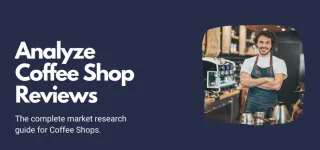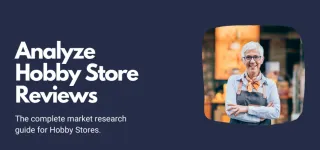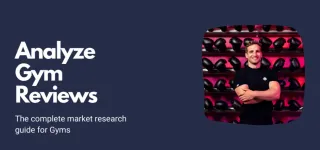Complete Market Research Guide for Fashion Stores
Jan 05, 2026 - 27 minute read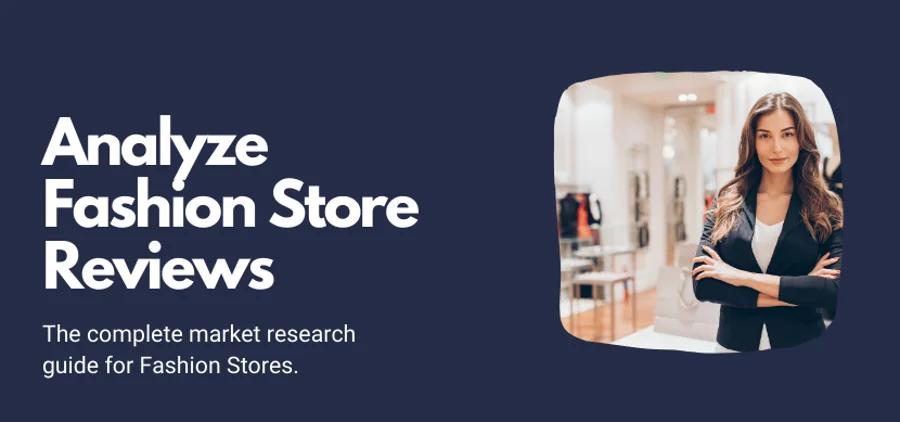
Introduction
Welcome to the fashion world, where trends evolve faster than you can say "couture" and where creativity meets commerce every single day. Fashion isn't just about clothes and accessories—it's about understanding people, cultures, and sometimes even predicting the future. Whether you're running an online boutique, a brick-and-mortar store, or dreaming of launching your own fashion venture, understanding the pulse of the market is crucial.
So, what exactly is market research? Think of it as your fashion store's secret weapon. Market research is the process of gathering, analyzing, and interpreting information about your market, consumers, competitors, and overall environment. It’s like having a crystal ball 🔮 giving you insights into what your customers want, what they’re buying, and what your competitors are up to. In an industry where consumer preferences can be as fickle as a feather in the wind, market research helps you stay ahead of the curve. It enables you to design collections that your customers will love, stock your store with trendy items, and set competitive prices. Without it, you’re essentially operating on guesswork—and in a dynamic industry like fashion, that’s risky.
Imagine opening a store full of your favorite designs 👗👛, but the foot traffic is sparse, and sales are sluggish. Or perhaps you’re running a thriving store, but suddenly, there’s a slump, and you can’t figure out why. This is where market research makes all the difference. It’s your roadmap for making informed decisions that align with what your customers really want. Market research can help avoid costly mistakes like overstocking inventory that doesn’t sell or missing out on trends your competitors are capitalizing on. It provides actionable insights, such as which products fly off the shelves and which ones gather dust. Whether you’re exploring a new market, trying to understand consumer behavior, or refining your business strategy, this guide will walk you through every step of the market research process tailored specifically for fashion stores.
So, buckle up and get ready to dive deep into the world of market research. By the end of this guide, you'll have a clear roadmap to navigate the ever-changing landscape of the fashion industry, ensuring your fashion store isn't just keeping up with trends but setting them. Let's get started!
Understanding Market Research in the Fashion Industry
Welcome to the first chapter of our "Complete Market Research Guide for Fashion Stores"! We’re thrilled to have you here as we uncover the ins and outs of market research specifically tailored for the fashion industry. Let's dive right in!
Fashion isn’t just a business—it’s an ever-evolving art form that reflects cultures, lifestyles, and even historical moments 🌍. Unlike many other industries, fashion thrives on creativity, innovation, and rapid change. One season it's all about minimalist chic, and the next, maximalism takes over. This constant flux makes fashion exciting but also incredibly challenging. To succeed, a fashion store needs to stay ahead of trends and truly understand its audience, which is where market research comes into play.
When it comes to market research, there are two main types you'll frequently encounter: qualitative and quantitative. Both are essential, each offering unique insights that can help your fashion store thrive. Qualitative research is all about understanding the "why" behind consumer behavior. It involves methods like interviews, focus groups, and open-ended surveys. Think of it as getting a peek into your customers' minds—what they love, what they dislike, and why they make certain purchasing decisions. In fashion, these insights can guide everything from design choices to marketing strategies.
On the flip side, quantitative research focuses on the numbers. It deals with data collection through structured surveys, statistics, and analytics 📊. This method helps you understand patterns and trends, providing a solid foundation for decision-making. For instance, knowing that 70% of your customers prefer eco-friendly materials can significantly influence your product line.
Market research has evolved dramatically over the years. Traditional methods like surveys and focus groups are still valuable, but modern technology has revolutionized how we gather and analyze data. Conventional methods include techniques like face-to-face interviews, telephone surveys, and mail questionnaires 📞✉️. While they offer a personal touch and in-depth insights, they can be time-consuming and often have limited reach.
Today, digital tools and AI-powered platforms have streamlined market research. Social media listening, online reviews, and big data analytics provide incredibly valuable real-time insights. Platforms like Kimola can even scrape and analyze customer feedback from various online sources, turning it into actionable market research reports. This blend of speed, accuracy, and vast reach is invaluable for making informed decisions in the fast-paced fashion world.
As we move through this guide, we'll explore these methods in more detail and showcase how they can be effectively applied to your fashion store. By understanding and leveraging both traditional and modern research techniques, you'll be well-equipped to navigate the dynamic terrain of the fashion industry. Stay tuned for more insights and practical advice as we delve deeper into each aspect of market research, ensuring your store isn't just following trends but setting them. Let’s keep the momentum going!
Defining Your Objectives and Research Questions
Now that we have a solid understanding of market research and its importance in the fashion industry, it's time to zero in on what you want to achieve. Defining clear objectives and crafting specific research questions are your foundational steps for success. Let’s get started!
First, take a moment to reflect on your core business goals. What do you want to achieve with your fashion store? Maybe you want to increase sales 📈, expand into new markets, or better understand your customer base. Clear, well-defined goals will steer your research in the right direction. For example, will you boost online sales by 20% in the next six months? Do you want to open a new physical store in a different city🏪? Or are you trying to understand why a particular product line isn’t performing well? By pinpointing these goals, you can focus your research on gathering the data needed to support these ambitions.
Once your core business goals are clear, it’s time to translate them into specific research questions. These questions will guide your research process and ensure you collect information supporting your objectives. The more precise your questions, the more targeted and valuable your insights will be. Here are some examples tailored for fashion stores: What styles and trends are currently most popular among my target demographic? How do my prices compare with those of my main competitors? Why do customers often praise or criticize my products in online reviews? Which marketing channels are driving the most traffic and sales for my store? What is the customer sentiment towards eco-friendly fashion, and how can I incorporate sustainability into my product line? These questions will help you gather actionable insights to apply to your strategies and operations directly.
Clear business goals and specific research questions are essential, but setting achievable and measurable objectives will take your market research to the next level. Objectives act as benchmarks for your success and provide a way to measure your progress. Consider using the SMART criteria to set your objectives: Be Specific in what you want to achieve. Instead of “increase sales,” aim for “increase online sales by 20%.” Ensure your objectives are Measurable so you can track your progress, such as “gain 500 new social media followers each month.” Make sure your goals are Achievable; don’t aim to double your sales in a month unless you have a solid strategy and sufficient resources. Keep your objectives Relevant and aligned with your broader business goals—if your main goal is brand awareness, an objective could be “increase blog traffic by 50% in the next quarter.” Finally, your objectives should be Time-bound to keep you on track, like “launch a new product line by the end of Q3.”
By setting objectives that follow these criteria, you’ll have a clear roadmap to measure your success and make data-driven decisions.
Understanding Your Target Audience
Now that we've set our objectives and crafted our research questions, it’s time to get to know the stars of your business—your customers!🌟 Understanding your target audience is key to tailoring your products and marketing strategies to meet their needs and preferences. Let’s dive in!
First up, let's talk demographics. Demographics are the statistical characteristics of your customers, such as age, gender, income, education, and occupation. These details are crucial for creating a clear picture of your typical customer. For example, are you catering to trendy teenagers, busy professionals, or stylish seniors? Knowing who your customers are will help you design products and marketing campaigns that resonate with them. You can use surveys, social media analytics, and even your sales records to gather demographic data. Platforms like Google Analytics can provide valuable insights into the age, gender, and interests of your online visitors. With this information, you can create targeted advertisements and stock your store with products appealing to your core customer base.
Next, let’s delve into psychographics. While demographics tell you who your customers are, psychographics reveal why they buy what they buy. This includes their attitudes, values, interests, and lifestyle choices. Understanding the psychographic profile of your audience can help you connect with them on a deeper level and create a more personalized shopping experience. Consider the following questions: What are your customers’ hobbies and interests? Are they health-conscious, environmentally aware, or trend-focused? What challenges do they face, and how can your products solve them? For instance, if your customers value sustainability, they may prefer eco-friendly fashion items. Alternatively, they might seek out versatile, easy-to-care-for clothing if they lead busy lives. You can use customer surveys, focus groups, and social media interactions to gather psychographic data. Engaging with your audience on platforms like Instagram or Facebook can provide insights into their preferences and lifestyles. The goal is to understand what your customers buy and why they buy it.
Finally, look at geographics—where your customers are located 📍. Understanding the geographical distribution of your audience can influence everything from product selection to marketing strategies. For instance, knowing where your customers live can help you choose the best location if you have a physical store. Understanding your customers' locations can guide your shipping policies and targeted advertising if you're an online retailer. Consider factors like climate, urban vs. rural settings, and regional trends. For example, customers in colder climates might prefer winter wear, while those in warmer regions could be more interested in summer styles. Additionally, urban customers might have different fashion preferences than those in rural areas. To collect geographic data, you can track your website’s traffic by location using tools like Google Analytics. You can also analyze your sales data to identify where most of your customers are based. Social media insights and location-based surveys can refine your understanding of your audience’s geographical distribution.
Combining demographic, psychographic, and geographic data will give you a comprehensive understanding of your target audience. This will enable you to create products, marketing strategies, and shopping experiences that truly resonate with your customers. Stay tuned as we continue our journey through the world of market research, ensuring your fashion store is tailored to meet the needs and desires of your audience! 💫
Location Analysis - Making Your Store Accessible
Now that we’ve explored understanding your target audience, it’s time to talk about location—where your fashion store will shine brightest. Whether you have a physical store, an online presence, or both, the location plays a crucial role in your success. Let’s dive in and find the perfect spot for your fashion haven!
First and foremost, let’s discuss why location is so vital. A prime location can be a game-changer for fashion retailers. For offline stores, being situated in a high-traffic area can significantly increase footfall, leading to higher sales and brand visibility. On the flip side, online stores benefit from understanding geographic hotspots where their target audience resides, allowing for targeted marketing and efficient distribution strategies. In essence, the right location makes your store more accessible to your customers, enhancing their shopping experience and boosting your overall success.
When it comes to brick-and-mortar stores, several factors should be on your radar. High foot traffic is a must; you want to be where people naturally congregate—think shopping malls, busy streets, or trendy neighborhoods 🏙️. Visibility is another critical aspect. Your store should be easily noticeable, with attractive signage and a welcoming storefront. Lastly, consider the proximity to competitors. While being close to other fashion stores might seem counterintuitive, it can actually be beneficial. Shoppers often visit areas with multiple options, increasing the likelihood they’ll walk into your store as well.
For online stores, your “location” is less about a physical space and more about understanding where your customers are 📍. Identifying targeted geographic markets can help you customize your marketing efforts and optimize logistics. For instance, if a significant portion of your customer base is from the East Coast, you might want to tailor your advertisements for that region and consider warehouses or distribution centers nearby to ensure timely deliveries. Knowing these geographic hotspots allows you to focus your efforts where they’ll have the most impact.
To make informed decisions about your store’s location, leverage modern tools and technologies. Geographic Information Systems (GIS) and mapping software are invaluable assets in this regard. Tools like Google Maps, ESRI, and other GIS platforms can help you analyze traffic patterns, competitor locations, and demographic data. These technologies offer visual representations of potential locations, making it easier to assess their suitability 📊. Platforms like Kimola can also provide detailed geographic insights from customer feedback and social media interactions. For example, you can identify regions with high concentrations of positive sentiments towards your brand or specific products. Combining these insights with traditional GIS data ensures a comprehensive approach to location analysis.
By considering these factors and utilizing advanced tools, you can select a location that maximizes accessibility and appeal to your target audience. Whether online or offline, the perfect location sets the stage for your fashion store’s success. Stay with us as we continue our journey through market research, ensuring your store is not just accessible but unforgettable! 🌟
Analyzing the Competitive Landscape
By now, you’ve got a good grasp on your target audience and the ideal location for your store. Next up, it’s time to turn our attention to the competition. Analyzing the competitive landscape is crucial for finding your unique edge and staying ahead in the fashion game. Let’s dive in!
First things first: who exactly are you up against? Identifying your key competitors is the starting point. Look at other fashion stores that cater to the same demographic or sell similar products 👗🛍️. These could be local boutiques, online retailers, or even big-name brands. Don’t forget to consider up-and-coming brands that might be flying under the radar but could pose a threat in the future. Take note of their strengths, weaknesses, product lines, price points, and customer reviews. Tools like social media, Google searches, and competitor websites can provide valuable insights. Remember, the goal here isn’t just to know who they are but to understand what they’re doing well and where they might fall short.
Once you’ve identified your competitors, it’s time for a SWOT analysis—a strategic planning tool that helps you evaluate your business in the context of the competitive landscape. SWOT stands for Strengths, Weaknesses, Opportunities, and Threats. Start by assessing your strengths: What does your store do better than your competitors? Maybe you have a unique product line, superior customer service, or a loyal customer base. Highlight these strengths and think about how you can leverage them even more.
Next, be honest about your weaknesses. Perhaps your website isn’t as user-friendly, or your marketing budget is limited. Identifying these weaknesses is the first step to addressing them. Then, look for opportunities in the market that your store can capitalize on. Are there emerging trends that you can jump on? Maybe there’s a customer need that competitors aren’t meeting. Lastly, recognize external threats that could pose challenges, such as new competitors entering the market or changes in consumer behavior. A thorough SWOT analysis will give you a clearer picture of where you stand and help you shape your strategies accordingly.
Benchmarking against competitors is another essential step. Benchmarking is comparing your business performance with your competitors to measure how you stack up in key areas and identify best practices you can adopt. Start by selecting key performance indicators (KPIs) relevant to your store, such as sales figures, customer satisfaction ratings, social media engagement, or website traffic. Gather data on these KPIs for both your store and your competitors.
Analyze the data to see where you excel and where you might need improvement. For instance, if a competitor's social media posts generate more engagement, look at what they’re doing differently—they might post more frequently, use eye-catching visuals, or actively engage with their audience in the comments. Use these insights to refine your strategy.
You'll gain a comprehensive understanding of the competitive landscape by identifying key competitors, conducting a SWOT analysis, and benchmarking against industry standards. This knowledge will empower you to make informed decisions and carve out a unique position in the market. Stick with us as we explore more aspects of market research, ensuring your fashion store stays ahead of the curve! 🚀
Collecting Data: Online and Offline Methods
Now that you’ve got a handle on the competitive landscape, it’s time to dive into the heart of market research—collecting the data. Online and offline methods offer valuable insights that can help shape your business strategies. Let’s explore the different ways you can gather this data!
The first step is secondary research, which involves using existing reports, studies, and databases. Think of it as standing on the shoulders of giants. Industry reports, market analysis documents, and public databases can provide a wealth of pre-existing information about market trends, consumer behavior, and competitive analysis 📚. Websites like Statista, Nielsen, and government databases are great starting points, offering valuable insights without the need to collect primary data yourself. For instance, you might find reports detailing consumer purchasing habits, demographic information, or emerging fashion trends that can inform your product line or marketing strategies. Leveraging these existing resources is a smart way to build a solid foundation of knowledge for your store.
While secondary research is incredibly useful, primary research allows you to gather data that’s specific to your fashion store 🎯. This is where you directly interact with your target audience through surveys, interviews, and focus groups. Surveys are fantastic for collecting quantitative data and can be distributed online via email, social media, or even in-store. Ask questions about shopping preferences, style influences, and purchasing behaviors to get a clear picture of what your customers want. For deeper insights, one-on-one interviews conducted in person, over the phone, or via video calls allow for more open-ended questions, providing detailed insights into consumer attitudes and motivations. Focus groups, which gather small groups of potential customers for open discussions, can spark ideas and feedback that might not emerge from surveys or interviews. Primary research gives you direct access to your customers’ thoughts and feelings, enabling you to gather unique and actionable insights that can’t be found in existing reports.
In today’s digital age, an enormous amount of data is generated online every day, and tapping into this can be incredibly powerful for your fashion store. Platforms like Instagram, Facebook, and Twitter are goldmines of consumer insights. Monitor your social media channels to see what customers say about your brand and products, and use social listening tools to track mentions, hashtags, and trends related to your industry 🕵️♀️. Online reviews on platforms such as Google Business, Trustpilot, and major e-commerce sites like Amazon provide honest feedback from your customers, allowing you to analyze reviews to understand what’s working well and where adjustments might be needed. E-commerce platforms like Amazon, eBay, and Etsy can also provide valuable data on customer preferences, best-selling items, and emerging trends. Tools like Google Analytics offer detailed information about your website visitors, including where they’re coming from, which pages they visit, and how long they stay, helping you optimize your site to better meet customer needs. Additionally, analyzing metrics from your email marketing campaigns, such as open rates, click-through rates, and conversion rates, can provide insights into what type of content resonates with your audience and drives sales.
By combining secondary research, primary research, and digital data collection, you’ll gain a comprehensive understanding of both the market landscape and your customers. This multifaceted approach ensures that you’re equipped with all the information you need to make informed, strategic decisions for your fashion store. Stay tuned as we continue our journey through market research, helping you gather and utilize data effectively!
Leveraging Technology for Market Research
As we explore the fascinating world of market research, it's time to see how technology can elevate your insights and take your fashion store to new heights 🚀. Modern tools don't just simplify the research process—they transform it, making it more efficient, comprehensive, and dynamic. Ready to embrace the future of market research? Let's dive in!
First, let’s talk about Kimola, your secret weapon for unlocking the power of digital feedback. With customer opinions scattered across platforms like Amazon, Google Business, Trustpilot, and social media, manually collecting and analyzing this data is nearly impossible. Recognize Kimola, the tech that scrapes this invaluable feedback and transforms it into actionable market research reports using advanced text analysis and natural language processing (NLP). Imagine a dashboard brimming with organized, ready-to-use data 📊, sparing you the hassle of sifting through countless comments and reviews. It’s like having your very own data wizard, highlighting trends, uncovering customer pain points, and spotlighting the features your audience loves.
Kimola understands that businesses have different needs when it comes to market research, which is why they offer two distinct products: Kimola.com and Kimola Cognitive.
Kimola.com: Quick and Efficient Analysis
Kimola.com is designed for businesses that need swift, one-time insights without delving too deeply into the complexities of ongoing analysis. Here’s why it stands out:
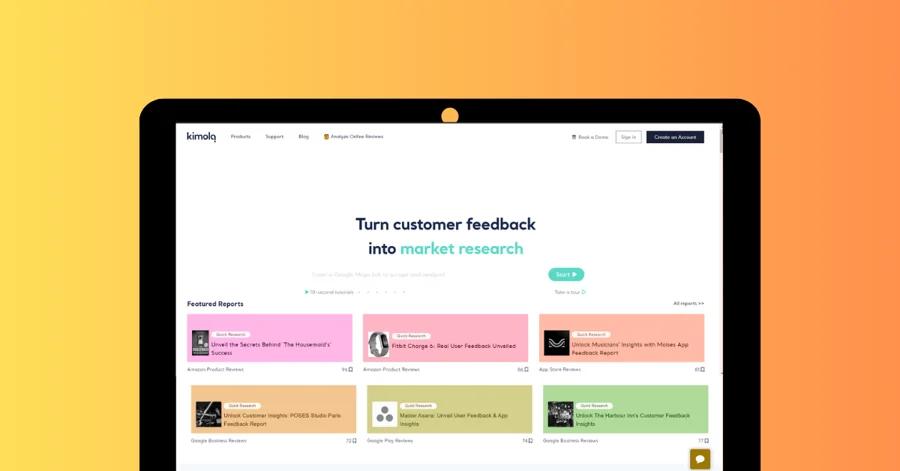
Fast and Focused: Kimola.com enables you to quickly gather insights from customer feedback across multiple platforms, perfect for fashion store owners needing rapid conclusions about specific trends or issues.
AI-Powered Sentiment Analysis: Utilizing NLP, it categorizes customer feedback into positive, negative, and neutral sentiments, giving you an immediate snapshot of overall customer satisfaction.
Topic Modeling: This feature identifies recurring themes within feedback, helping you quickly understand common areas of concern or satisfaction.
Kimola Cognitive: In-Depth, Continuous Analysis
Kimola Cognitive, on the other hand, is tailored for businesses seeking comprehensive, ongoing analysis 📈. It’s your go-to tool for maintaining a continuous pulse on customer feedback:
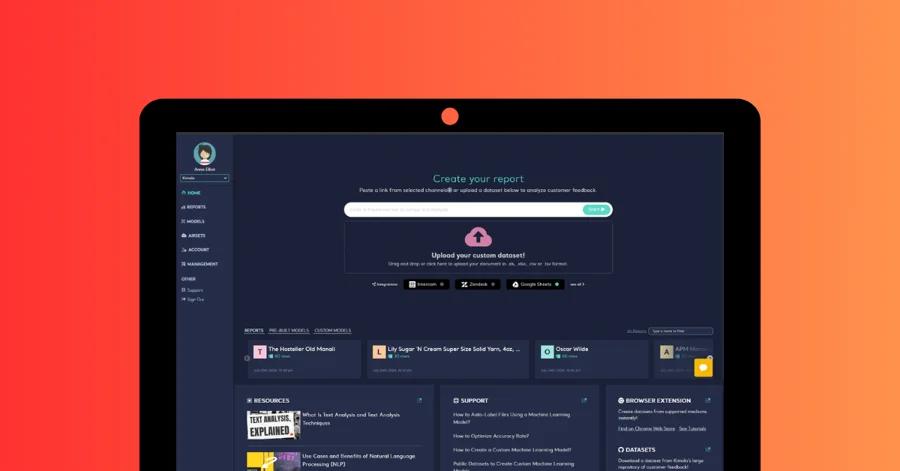
Aspect-Based Sentiment Analysis: Powered by advanced NLP techniques, this feature dives deeper, analyzing specific elements of feedback such as product quality, style, or pricing, providing a granular view of customer opinions.
Custom Data Sets: Analyze custom data sets through an intuitive drag-and-drop interface, offering greater flexibility in your research.
Multi-Label Classification: Captures reviews where customers discuss multiple topics, ensuring a rich, nuanced understanding of feedback.
Advanced Outputs: Generates diverse insights, including executive summaries, buyer personas, SWOT analyses, and more, facilitating strategic, informed decisions.
Kimola.com and Kimola Cognitive allow you to export your analysis reports in various formats—Excel, PDF, or PPT—catering to different reporting needs. Additionally, you can choose from six different language options for your reports, ensuring that the insights are easily shareable and understandable across your team, regardless of their language preference.
Incorporating both Kimola.com and Kimola Cognitive into your market research arsenal can revolutionize how you gather and analyze customer feedback. Whether you require quick insights or in-depth, continuous analysis, these tools streamline the research process and make data-driven decision-making a reality.
By harnessing the power of Kimola bolstered by advanced text analysis and NLP—you can revolutionize your understanding of customer feedback. This integrated approach enables you to make smarter, data-driven decisions that keep your fashion store ahead of the curve. Stay with us as we continue to unlock the secrets of market research, driving your fashion store towards unparalleled success! 🌟
Turning Data into Actionable Insights
Now that we’ve explored how to collect and analyze data using advanced technologies, it’s time to focus on the most exciting part—turning that data into actionable insights 🛠️. The goal is to transform raw data into strategies that will drive your marketing and sales efforts to new heights. Sound good? Let’s get started!
So, you’ve gathered a wealth of data from various sources—customer feedback, social media interactions, online reviews, and more. But what’s next? The key to making this data work for you is to uncover patterns and trends that can inform your business decisions. Start by looking for recurring themes in your data. For example, are customers frequently praising your store’s fast shipping times? Or perhaps they’re often mentioning issues with product sizing. Identifying these patterns helps you understand what you’re doing right and where improvements are needed. Tools like Kimola make this process easier by using text analysis and natural language processing (NLP) to highlight these recurring themes and sentiments in the data.
Visualizing your data can also reveal trends that might not be immediately obvious. Charts, graphs, and heatmaps can help you see fluctuations in customer sentiment over time, seasonal trends in product interest, or geographic areas with higher engagement. Utilize the data to enhance personalization in your customer interactions. Whether through personalized email marketing, product recommendations on your website, or tailored social media ads, customised experiences can significantly increase customer satisfaction and loyalty 🎯. For example, if a customer frequently buys athleisure wear, send them customised offers or new arrivals in that category.
Analyze which marketing channels are driving the most traffic and sales. If social media campaigns outperform email marketing, it may be worthwhile to allocate more of the budget towards social media 📱.
Conversely, it might be time to tweak your email content or call-to-actions if your email open rates are high but low conversion rates. Your data can also provide insights into how your competitors are performing. Monitor their marketing strategies, customer reviews, and product offerings. Benchmark your performance against theirs to identify areas where you can gain a competitive edge. Finally, make sure to regularly measure the impact of your strategies and be ready to adapt. Customer preferences and market conditions can change rapidly, so it’s important to stay agile. Regularly update your market research and tweak your strategies based on the latest insights.
Turning data into actionable insights is all about making informed decisions that align with your business goals and resonate with your customers. By consistently analyzing patterns and trends and applying these insights to your marketing and sales strategies, you can ensure your fashion store isn’t just keeping up with the competition but leading the charge 🚀. Stay tuned as we continue to unlock the full potential of market research, helping your fashion store shine in a crowded market!
Forecasting Future Trends in the Fashion Industry
We've covered a lot of ground, from understanding your audience to leveraging technology for market research. Now, let's look ahead and discuss how you can forecast future trends in the ever-evolving fashion industry. Ready to become a trendsetter? Let’s dive in!
Predictive analytics is like having a crystal ball for your business, except data power it. By analyzing historical data, you can identify patterns and trends that give you a glimpse into the future. In the fashion industry, this means looking at past sales data, seasonality trends, and consumer behavior to predict what will be in vogue next season or year. For instance, if your data shows a consistent rise in the popularity of eco-friendly materials over the last few years, it’s a safe bet that this trend will continue. By focusing on sustainable fashion, you can align your product offerings with consumer demand. Similarly, if certain styles tend to peak during specific seasons, you can plan your inventory and marketing strategies accordingly. Predictive analytics helps you stay ahead of the curve by turning past data into future insights.
Artificial intelligence (AI) is revolutionizing many industries and fashion is no exception. Regarding trend forecasting, AI can analyze vast amounts of data faster and more accurately than humans. AI algorithms can sift through social media posts, customer reviews, and online searches to identify emerging trends and predict which ones will gain traction. Imagine knowing that neon colors are about to come back before your competitors do, all thanks to AI-powered trend forecasting. You can gain real-time insights into shifting consumer preferences by integrating AI tools into your market research strategy. With AI, you’re not just reacting to current trends—you’re anticipating and setting them.
In the fast-paced world of fashion, staying ahead means never stopping. Continuous market research is your secret weapon for maintaining a competitive edge. Instead of viewing market research as a one-time task, make it an ongoing practice. Regularly update your data, track emerging trends, and adjust your strategies in real-time. There are several ways to ensure your market research efforts are continuous. First, keep an eye on your competitors. What are they doing well? Where are they falling short? Use tools that allow you to monitor their activities and compare them against your own. Secondly, stay connected with your customers. Social media platforms, customer feedback, and direct surveys are invaluable tools for understanding their evolving preferences and needs.
Embrace tools that facilitate continuous research. Use analytics platforms that provide real-time insights and automated updates. With tools like Google Analytics, SEMrush, and Kimola Analytics, you can continuously gather and analyze data, ensuring you’re always in the know. Incorporating predictive analytics, AI, and continuous research practices into your strategy will help you stay ahead in the dynamic fashion industry. By understanding what’s coming next, you can make informed decisions that resonate with your customers and keep your fashion store at the forefront of emerging trends.
As you continue to harness the power of market research, remember that the fashion industry is all about creativity and innovation. Use these insights to not only follow trends but to create them. Stay tuned as we wrap up our guide and help you become a true trendsetter in the fashion world! ✨
Conclusion
Congratulations! 🎉You’ve reached the end of our "Complete Market Research Guide for Fashion Stores." We've journeyed through understanding your audience, analyzing competitors, leveraging advanced tools, forecasting future trends, and much more. Now it's time to wrap things up and reflect on how you can use these insights to propel your fashion store to new heights. 🚀
Market research isn't just a set of tasks; it's an ongoing journey that helps you stay tuned in to your customers' needs and the ever-shifting landscape of the fashion industry. You can make informed decisions that keep your store ahead of the curve by regularly updating your data, monitoring customer feedback, and staying agile.
We hope this guide has equipped you with the knowledge and confidence to dive deep into market research. Understanding patterns and trends in your data allows you to tailor your marketing and sales strategies more effectively. Leveraging technology, like Kimola and AI tools 🤖, can give you unprecedented insights and automate many of your processes, making your job easier and more efficient.
Remember, the fashion industry is as much about creativity as it is about understanding your market. Use these insights to not just follow trends but to set them, creating unique, compelling offerings for your customers.
Most importantly, keep the lines of communication open with your customers. Their feedback is gold, giving you the clues needed to refine your products and services continually. Engage with them on social media, listen to their reviews, and make them feel valued. A customer-centric approach will always serve you well.
Lastly, acknowledge that market research is a marathon, not a sprint. Stay curious, be willing to adapt, and celebrate the small victories along the way 🏅. Your dedication to understanding and serving your audience is what will truly set your fashion store apart.
Thank you for joining us on this journey. We hope you feel inspired and ready to take your market research efforts to the next level. Here’s to your continued success and to setting new trends in the fashion world. Stay fashionable, stay informed, and most importantly, enjoy the journey! 🌟

